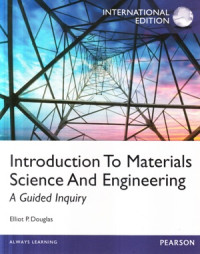Text
Introduction to materials science and engineering : a guided inquiry
This is not a typical textbook. Typical textbooks really serve as reference texts, a place where students can go to find information that they need. This text is . I designed with a very different goal in mind. It is a learning tool, a book that students use to help them learn. Thus, two very important philosophies underlie it:
1. Students learn by being actively engaged. The theory of constructivism states that learn¬
ing occurs when learners "think about what the teacher tells them and interpret it in
terms of their own experiences, beliefs, and knowledge."1 One practical application of
the constructivist approach is through the learning cycle model.2"4 In this model there are
three phases of learning. The first is exploration, in which the learner manipulates data
or information. This leads to the second phase, concept invention or term introduction.
In this phase the learner uses the data to develop general rules or concepts. Finally, in
the application phase, the learner applies the concepts developed to new situations.
This learning cycle models both the way scientific research is done and the way young
children learn about their world. Traditional teaching skips the exploration phase and
begins with concept invention. Studies have shown, however, that learning occurs
better when the concept invention phase comes later in the sequence3'5> 6 and when
the learners themselves invent the concepts (rather than being told about them). This
approach to learning is the basis for constructivism. In a constructivist approach the
roles of the instructor and students are quite different from those in a traditional class.7
In the approach used in this text, students work together in teams to come to a common
understanding of new concepts.
2. Students do not need to be told every detail about every topic. Rather, they need to learn
the fundamental concepts. For example, this book does not have information about all
14 Bravais lattices. Rather, it focuses on the cubic crystal systems, with the idea that these
systems serve as models from which students can learn the important concepts of crystals.
This book can be used in many ways, but was written based on the approach of Process-Oriented Guided Inquiry Learning (POGIL). POGIL was initially developed as a means of teaching general chemistry and has since spread to many other fields. POGIL is used in many different ways, but its basic approach shifts the primary responsibility for learn¬ing from the instructor to the student. There are many resources at the POGIL website (http://pogil.org/), including a detailed Instructor's Guide to POGIL (http://pogil.org/ resources/implementation/instructors-guide). The preface you are reading now describes how I use it in my 100-student Introduction to Materials class. For more details and other tips on how to implement POGIL in your class, you should get the free Instructor's Guide from the POGIL website.
In my POGIL class I do not lecture. Rather, students work in teams, typically of four stu¬dents, using the book as their guide. Each section of the text has three primary components: 1) data or information as background material; 2) guided inquiry questions, which are designed to lead the students to understanding the fundamental concepts represented by the data; and 3) application questions (end-of-chapter problems), which provide the students with practice in solving problems using the concepts they have derived. My role is to guide the students, walking around the room and probing them with questions to check their under¬standing. Farrell et al. have described the roles of students within the groups and the class procedures.
Ketersediaan
Informasi Detail
- Judul Seri
-
-
- No. Panggil
-
620.11 Dou i
- Penerbit
- London : Pearson., 2014
- Deskripsi Fisik
-
374 hal. : il. ; 25 cm.
- Bahasa
-
English
- ISBN/ISSN
-
9781292004839
- Klasifikasi
-
620.11
- Tipe Isi
-
-
- Tipe Media
-
-
- Tipe Pembawa
-
-
- Edisi
-
-
- Subjek
- Info Detail Spesifik
-
-
- Pernyataan Tanggungjawab
-
-
Versi lain/terkait
Tidak tersedia versi lain
Lampiran Berkas
Komentar
Anda harus masuk sebelum memberikan komentar

 Karya Umum
Karya Umum  Filsafat
Filsafat  Agama
Agama  Ilmu-ilmu Sosial
Ilmu-ilmu Sosial  Bahasa
Bahasa  Ilmu-ilmu Murni
Ilmu-ilmu Murni  Ilmu-ilmu Terapan
Ilmu-ilmu Terapan  Kesenian, Hiburan, dan Olahraga
Kesenian, Hiburan, dan Olahraga  Kesusastraan
Kesusastraan  Geografi dan Sejarah
Geografi dan Sejarah